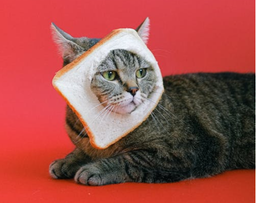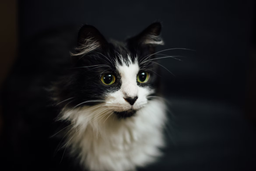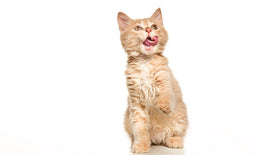Can cats eat bread? Get the definitive answer
While not their first choice of food, you might stumble upon your feline nibbling on bread. Is it harmful to cats? Unfortunately, the answer is not black and white.
Untamed explains whether bread has a place in your cat’s diet. Find out if cats can eat bread and:
- What happens if they do?
- Does the type of bread matter?
- What should you do if your cat eats bread?
- Do cats even like it?
- What are healthier alternatives to bread?
- What can cats not eat at all?
Should cats eat bread?
Veterinarians suspect that felines are attracted to the taste of yeast, which is one of the reasons pastry is not the best meal for your kitty.
The main reasons why bread is harmful to cats are:
- Grain
- Carbohydrates
- Yeast
Why is grain bad for cats?
Many felines suffer from food allergies, and grain is one of the most common allergens for cats. Felines also cannot absorb nutrients from plants because they are obligate carnivores. Fruits and veggies are redundant in your cat's meal plan, and strict vegan diets are pretty harmful to felines.
Aren’t carbs good for cats?
Carbs are not dangerous per se but can't add any nutritional value to your cat’s diet. You can include dietary fibre in your feline’s diet, but you should keep it under 3% of their meals. On average, 50% of any baked bread is made of carbs, and that’s too much for cats.
If you’re going to give pastry to your kitty, keep it minimal because a carb overload can cause obesity and diabetes in cats.
Felines who eat only dry food are also at risk because biscuits are high-calorie bombs. Cat kibble must be complemented with wet food, soup, or bone broth to keep the nutrition balanced.
Why is yeast bad?
Yeast in baked bread doesn’t pose a danger, but the raw dough is toxic to cats.
Raw yeast ferments in the feline stomach, creating two compounds:
- Ethanol—Attacks the nervous system and causes organ failure
- Carbon dioxide—Builds up in the stomach and causes it to twist, leading to a potentially fatal condition called gastric dilatation volvulus (GDV)
If your cat ate raw bread, take them to the vet immediately.
How much bread can cats eat?
The recommended daily food intake for cats is 40–45 calories per kilogram of healthy body weight. For an average 4 kilo cat, this equals 160–180 calories per day. Since most types of bread have around 260 calories per 100 grams, your cat can have less than 10 grams of bread (one-third to one-half of a slice) as a treat. Toast contains more calories than plain bread (313 calories), so your kitty can have a maximum of one-quarter of a slice.
If you decide to give bread as a treat, opt for plain bread only. Special types of bread can be good for humans because we’re omnivores, but cats need meat to thrive.
Ingredients commonly found in pastry that are toxic to cats
You should always avoid bread containing:
- Garlic or other allium vegetables (not even as a spread, such as chive cream cheese)—The disulfides and thiosulphates in allium vegetables cause damage to red blood cells, often resulting in anaemia
- Raisins—The exact reason for their toxicity is unknown, but you should avoid giving them to your cat altogether
Other potentially harmful kinds of bread
The following items are not toxic but can cause vomiting, weight gain, stomach upsets, and loose stools:
- Banana bread and French toast—They have a high carbohydrate and fat content
- Brioche—Eggs and milk are not appropriate for cats and cause stomach upsets if eaten separately, let alone mixed with salt, flour, and yeast
You should also avoid any bread containing nuts since they have a lot of fatty acids and could cause gastrointestinal problems if ingested in larger amounts. Nuts (especially macadamia) are common allergens, so they should be off-limits to cats.

Are you making fun of me, mum?
Source: kwangsuporn
What happens when a cat eats bread?
Most cats can handle a bit of bread, but sensitive felines could show the following symptoms after ingestion:
- Vomiting
- Seizures
- Hair loss
- Lip ulcers
- Coughing
- Diarrhoea
- Scratching
- Weight loss
- Loose stools
- Ear infections
- Loss of appetite
- Cracked paw pads
- Excessive ear wax
- Excessive grooming
- Bacterial skin infections
- Rubbing face on objects
- Skin lesions, scabs, and rashes
- Itchy, reddened, and inflamed skin
- Scooting rear end on floor or carpets
If your cat eats bread and you notice any of these symptoms, take them to the vet immediately.
What happens next?
The vet will ask you how much bread the cat ate, what kind of bread it was, and whether your cat has any food allergies or intolerances.
The diagnostic procedure should include:
- Blood work
- Skin tests
- Urinalysis
- Skin or intestinal biopsies
The vet will probably suggest a hypoallergenic diet without any common allergens and slowly reintroduce specific ingredients to confirm the diagnosis. Your cat might have to switch to single-source protein meals since they are less likely to cause an allergic reaction.
If your cat ate raw bread dough or yeast, the vet will administer treatment to help your cat get rid of the toxins and alleviate the accompanying symptoms.
Can bread be combined with cat food?
You should not combine bread with cat food because carbohydrates are useless and potentially harmful to cats, especially if your kitty is on dry biscuits. Many commercial products already have a lot of carbohydrates, and adding bread to the mixture would create a carb overload.
Can cats eat bread and milk?
Bread and milk is often a go-to meal for cat parents whose felines have lost their teeth. The mix is soft enough and provides a significant amount of calories in a small portion.
This combo is bad for cats because of carbs and lactose, which most felines cannot break down in their digestive tract.
Cats shouldn’t drink milk even if the product in question is lactose-free (such as soya milk) or has added lactase since they could have gastrointestinal problems. Some felines are also allergic to casein, a particular protein in milk.
Can cats eat other kinds of baked goods?
You shouldn’t give your cats pie, cake, biscuits, or other pastry because they typically have even more carbohydrates and fat than bread. Numerous products are also full of ingredients toxic to cats, such as cured meat (bacon), chocolate, or vegetables.

Why can’t I have biscuits?
Source: gray_the_furball
Why do cats eat bread?
Felines often crave other ingredients they can smell in the pastry, especially if specific meat derivatives or eggs are added. The only occasions in which cats eat bread by themselves are malnourishment and nutritional deficiency.
Signs that your cat is still hungry
Your cat’s appetite and caloric needs depend on many factors, such as their size, breed, and lifestyle (completely indoors or with outdoor access). Another factor to keep in mind is whether your cat is fixed—felines who are spayed or neutered can have appetite swings after surgery.
Some of the signs that your cat might still be hungry include:
- Grinding on your legs
- Leading you to the feeding area
- Intense vocalisation
- Eating quickly when food is served
- Stealing food from your hands or the table
- Throwing up undigested food
- Playing with their empty food dish
Cats might seem to be more hungry because of an altered eating schedule or a new food brand. If you’re sure that you’re giving your cat enough food, you should take them to the vet. Increased appetite can be a symptom of many health problems.
Symptoms of nutritional deficiency
Cats can have appetite issues when their food doesn’t contain enough essential nutrients, such as:
- Protein (amino acids, the most important one being taurine)
- Fat (fatty acids, including omega-3 and omega-6)
- Moisture (the recommended amount in food is 70%)
Some signs that your cat’s diet might not be nutritionally adequate include:
- Rough and dull coat
- Excessive shedding
- Lethargy
- Dilated pupils
- Poor coordination
- Weight loss
You should always consult your vet about the quality of specific cat food before giving it to your furry friend to avoid nutritional deficiency.

This smells soooo good. I bet if I took a tiny bite, mum wouldn’t even notice.
Source: martrielle
What should cats eat instead of bread?
Cats should eat food with 50% or more animal-sourced protein and up to 20% fat.
Foods that best fit the criteria are:
|
Category |
Food |
|
Meat |
|
|
Fish |
|
|
Crustaceans |
|
You can occasionally give your cat a tiny bit of pork or beef as a treat, but not more because the fat content is too high. Deli meats also work as a treat, so you can include a thin slice of ham as an appetiser or taste enhancer.

What do you mean photo props are not food? I demand answers, human!
Image (c) Untamed
If bread is bad, what type of cat food should you give your cat?
Most commercial cat food comes in three forms:
- Dry food—Biscuits are typically the most affordable product but are low in moisture, so you would need to add some bone broth or soup to keep your cat hydrated
- Wet food—Jelly and gravy products come super close to a natural feline diet thanks to their high moisture content
- Semi-moist food—Most commercial semi-wet food is packed with sodium and artificial ingredients, such as flavourings and colourings
- Many cat parents mix several brands and types of cat food to ensure their furry friend enjoys the benefits of all of them. Commercial treats for cats usually fit in one of the categories mentioned above.
Can cats eat raw food?
Raw food isn’t suitable for domestic cats because it could transmit harmful microorganisms, such as fungi, viruses, bacteria, and parasites. Wild cats eat their prey fresh, while bought meat is processed for preservation and more likely to go bad.
Your furry friend could even transmit some of these microorganisms to you, so it’s safer not to feed your cat raw meat.
If you decide to prepare homemade meals for your furry friend, steaming is the best way to process chicken or other ingredients.
Untamed—healthy and tasty meals for your kitty
All cats thrive on a high-protein diet, including Bengals, Persians, Ragdolls, Siamese, Maine Coons, British Shorthairs, or rescue kitties. The same goes for their life stage—kittens, adults, or seniors need whole meat to stay healthy.
Untamed prepares the finest sustainably sourced meat, fish, and crustaceans of human-grade quality. The ingredients we use are gently steamed to keep their natural aroma and nutritional value.
Our recipes contain no:
- Grain
- Vegetable derivatives
- Artificial flavouring or colouring
- Meat derivatives
- Harmful chemicals
If your feline has a delicate stomach, you can try our single-source protein products—Chocka Chicken and Tuck-in Tuna.
Don’t know whether your kitty would agree? Order our taster pack NOW and find out!
How to order Untamed
You can get a tailor-made taster pack for your furry friend by:
- Visiting our Try Now page
- Completing our short questionnaire
- Selecting a meal plan and confirming your order
The trial cat food pack will be on your doorstep in one day, and if your feline companion loves it, you can get a steady supply every month. You can also modify, pause, or cancel your order at any moment.
Are you scared to make the switch? Many kitty parents who have eased into our monthly cat food subscription report the following positive changes in their felines:
|
When |
What changed |
|
Week one |
|
|
Month two |
|
|
Month four |
|
|
For life |
|

I’d better get out of this box before my mum takes it away from me like the bread the other day.
Image (c) Untamed
My cat doesn’t want to switch to new food. What should I do?
Cats are creatures of habit and don’t react well to changes, especially those in their feeding schedule. If your cat is a finicky eater used to one particular brand of food, the change must happen slowly and gradually.
To get your furry friend used to their new food, mix 90% of their old food with 10% of the new product in the first meal. Increase the amount of the new item by 10% daily. In ten days, your cat will be on a different diet without noticing it.
If your cat is of the stubborn kind, you should also:
- Warm the meal up to room temperature to enhance the aroma
- Add a dash of water to release the flavours and soften the food
- Season the dish with special pet food spices
What are healthier alternatives to bread?
If you want to include dietary fibre in your cat’s diet, the following products are better for your feline than bread:
- Couscous
- Millet
- Rice
These grains have a fine texture, and some cats like them. Keep in mind that felines get all essential nutrients from meat, so introduce extra fibre only if your vet recommends it. Cats also tend to chew some grass when they need fibre, so you probably won't have to focus on this nutrient in their diet.
If a kitten eats too much bread or pastry, they won't be able to develop properly. Senior felines can become obese, mainly because they are not as active as they used to be.
Foods you should never give to your feline
Bread isn’t the only food causing health problems in felines.
Other human foods harmful to cats include:
|
Item |
Why is it dangerous? |
|
Coffee and chocolate |
The caffeine and theobromine in these products are toxic to cats |
|
Citrus fruits |
Citric acid causes severe stomach upsets |
|
Mushrooms |
Wild mushrooms are dangerous and can be toxic even in tiny amounts |
|
Coconut flesh and milk |
Coconuts are rich in fat and potassium, which can increase blood acidity in cats |
|
Artificial sweeteners (such as xylitol) |
This sugar substitute (commonly found in no-sugar products) causes vomiting, lethargy, and liver failure in cats |
|
Small and uncooked bones |
Bones pose a choking hazard and could cause internal injuries |
|
Fat trimmings |
Excessive fat consumption causes digestive issues and pancreatitis |
|
Fresh grapes |
Grapes are toxic to cats, although the reason is not clear |
If you’re giving your cat bread, it’s best to keep it plain and put no spreads or extras on top of it.
Products that don’t cause immediate damage but are inappropriate for cats
Some items that don’t cause significant harm to felines immediately (but don’t benefit them, either) are:
- Peanut butter—Nuts are harmful to cats, and peanut butter has a high fat content and contains enough sodium to be considered toxic to felines (if fed in large amounts)
- Dairy products (such as cheese or yoghurt)—These products are rich in fat. If given in large amounts, they can cause stomach upsets in felines
- Some fruits—An occasional slice of an apple or banana or a single small strawberry after lunch won’t harm your cat, but felines don’t benefit from fruits. Cats who eat a lot of fruit could gain weight and become sick because of the high carbohydrate content
Check out our other guides to what cats can or cannot eat:
|
|

![Best food for Ragdoll cats in the UK [Broken Down]](http://untamed.com/cdn/shop/articles/featured_best_food_for_ragdoll_cats_uk.jpg?v=1646818249&width=256)

